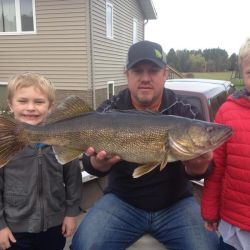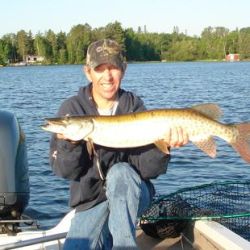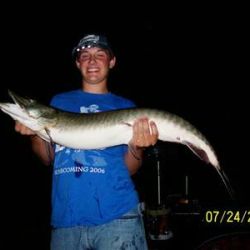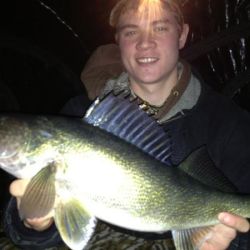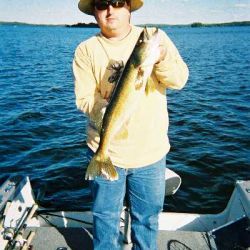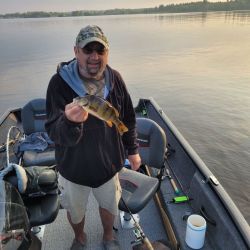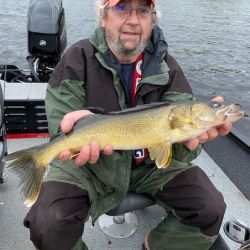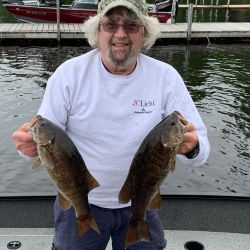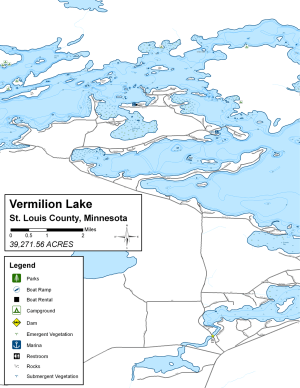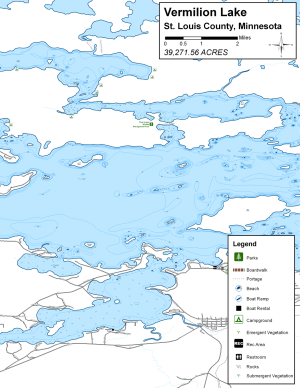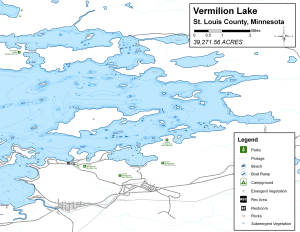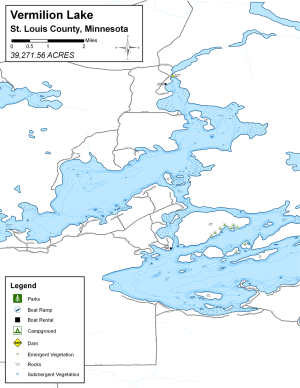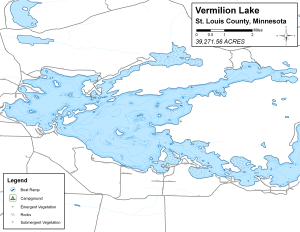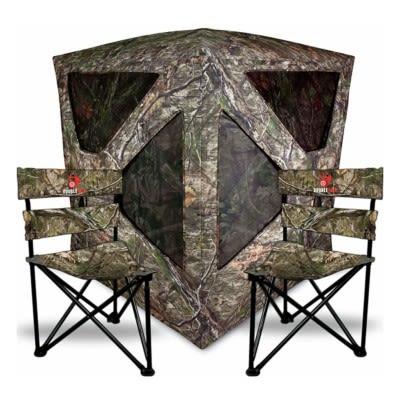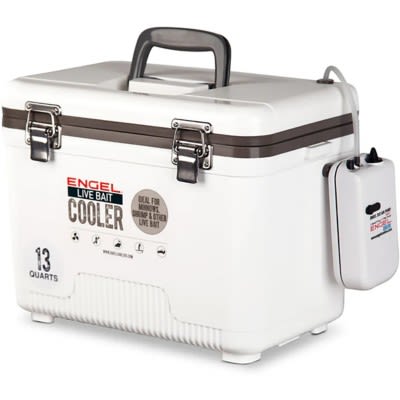Today's Best Fishing Times
Get the best fishing times for Lake Vermilion with Lake-Link's Fishing Forecast. SEE MORE
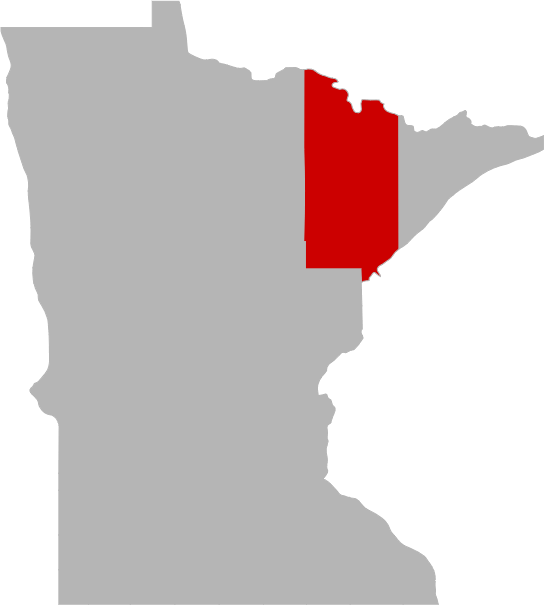
Vermilion Lake is known for its excellent fishing, particularly for walleye, northern pike, and smallmouth bass, which are all prized game fish. The lake is also home to a variety of other fish species, such as muskie, crappie, and sunfish, making it a popular spot for anglers.
In addition to fishing, Vermilion Lake offers a variety of other recreational opportunities, such as boating, swimming, and hiking. The lake has several public boat ramps and marinas, as well as several beaches for swimming and sunbathing. The surrounding Superior National Forest has several hiking trails, including the popular Superior Hiking Trail, which runs through the area.
The lake and its surrounding area are also rich in cultural and historical significance. The area was historically inhabited by the Ojibwe people, and several Ojibwe communities still reside in the area. The lake and surrounding forests also have a rich logging history, and several historical sites and museums in the area commemorate this industry.
Overall, Vermilion Lake is a beautiful and diverse destination that offers a wide range of recreational opportunities and natural attractions for visitors to enjoy. Whether you are an angler, boater, hiker, or history enthusiast, Vermilion Lake and the surrounding Superior National Forest have something for everyone to enjoy.

Explore Lake Vermilion
Share your catch!
We want to see what you've caught on Lake Vermilion.Frequently Asked Questions About Lake Vermilion, MN
- How big is Lake Vermilion?
- How deep is Lake Vermilion?
- What kind of fish can you catch in Lake Vermilion?
- Are there fishing guides or charters for Lake Vermilion?
- Are there places to stay in the Lake Vermilion area?
- Are there topographical lake maps available Lake Vermilion?
- Are there boat launches on Lake Vermilion?
- Are there places to eat and drink near Lake Vermilion?
- What are the fishing regulations for Lake Vermilion?
- What is the average air temp for Lake Vermilion?
- Are there any state parks near Lake Vermilion?
How big is Lake Vermilion?
How deep is Lake Vermilion?
What kind of fish can you catch in Lake Vermilion?
Other fish species in the lake include Blackchin Shiner, Blacknose Shiner, Blackside Darter, Bluntnose Minnow, Cisco (Tullibee), Fathead Minnow, Finescale Dace, Golden Shiner, Green Sunfish, Hybrid Sunfish, Iowa Darter, Johnny Darter, Lake Whitefish, Logperch, Mimic Shiner, Ninespine Stickleback, Shorthead Redhorse, Tadpole Madtom, Trout-Perch and White Sucker.
Are there fishing guides or charters for Lake Vermilion?
Are there places to stay in the Lake Vermilion area?
More Lodging Options
Lake-Link Featured Lodging

Are there topographical lake maps available Lake Vermilion?
Are there boat launches on Lake Vermilion?
Lake Vermilion area businesses:


Are there places to eat and drink near Lake Vermilion?
What are the fishing regulations for Lake Vermilion?
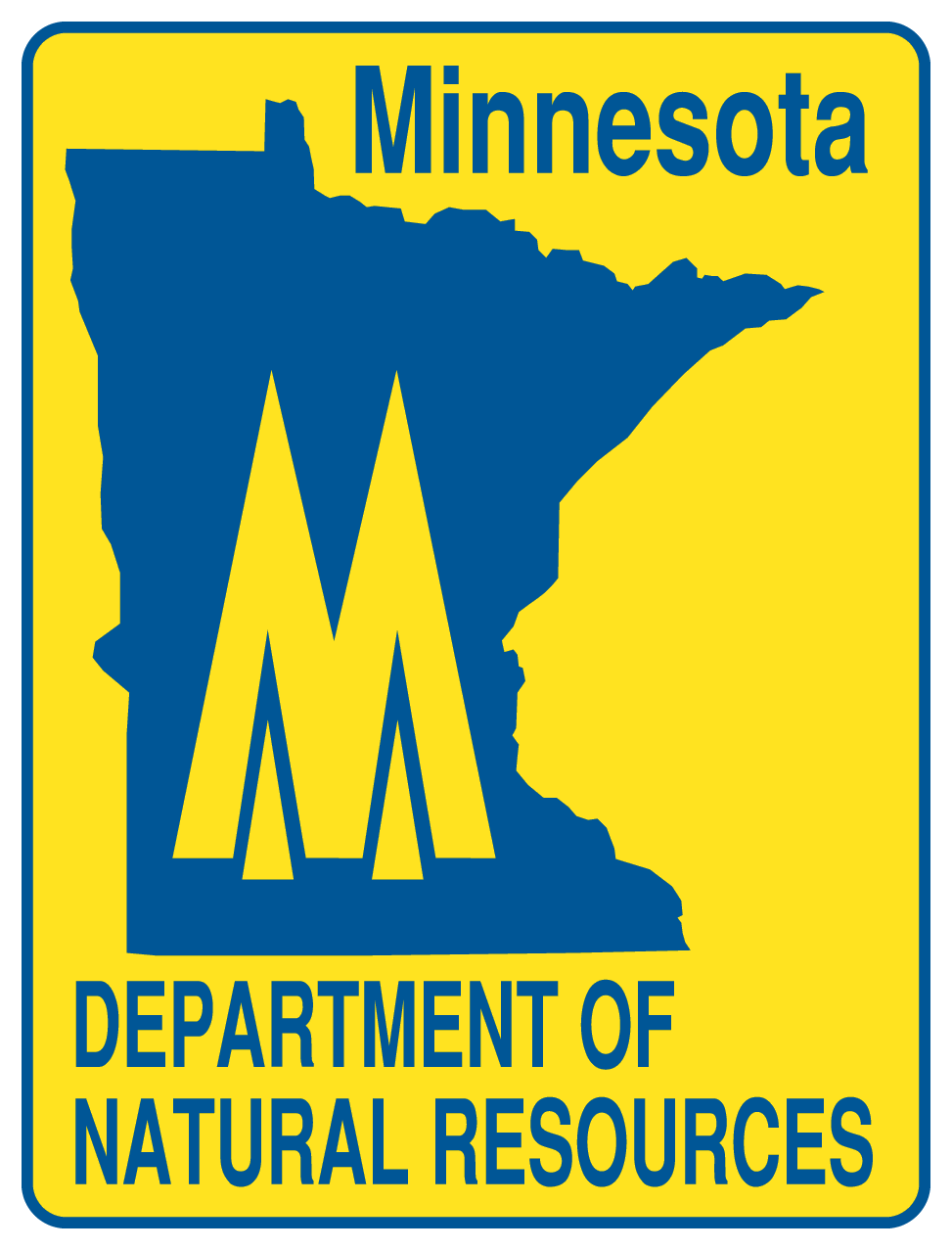 There are specific fishing regulations Lake Vermilion that you need to know. For complete fishing regulations visit the Minnesota Department of Natural Resources. To report a violation call (800) 652-9093. Need a Minnesota fishing license?
There are specific fishing regulations Lake Vermilion that you need to know. For complete fishing regulations visit the Minnesota Department of Natural Resources. To report a violation call (800) 652-9093. Need a Minnesota fishing license?
Explore the Lake Vermilion area in a RV
Are you looking for an adventurous vacation option that won't break the bank? Look no further than renting an RV! Contrary to popular belief, the process is much simpler than you might imagine. With just a few easy steps, you'll soon be experiencing the ultimate freedom and convenience of exploring the open road in your very own recreational vehicle. And the best part? RV travel can save you up to 60% compared to other types of vacations! With the money you'll save, you'll be able to travel even more and create unforgettable memories along the way. So why wait? Start planning your next adventure today with an RV rental. Learn more about renting a RV.
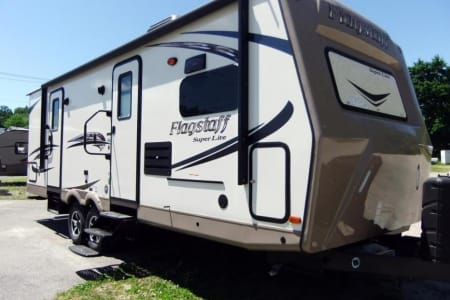
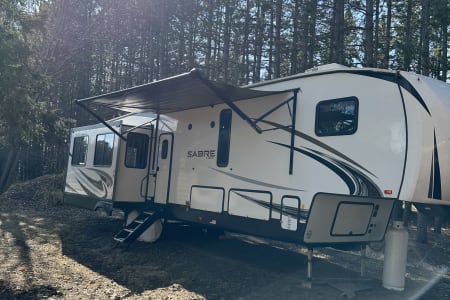
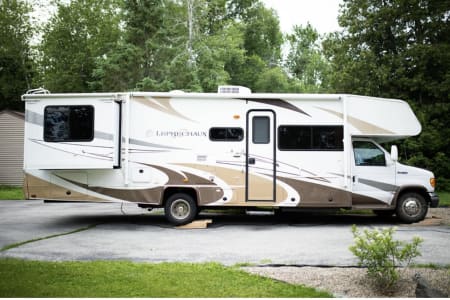
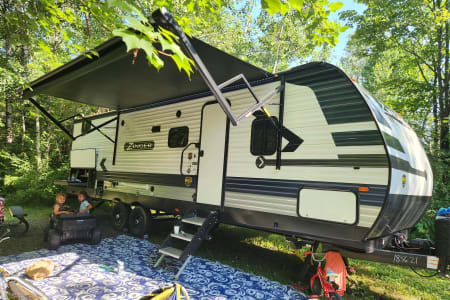
What aquatic invasive species are found in Lake Vermilion?
Join us in the fight to prevent the spread of invasive species These sneaky creatures can hitch a ride on boats, clinging onto propellers, anchor lines, and trailers. They can even survive in hidden places like bilge water and ballast tanks, or disguise themselves in dirt and sand that sticks to nets, buckets, anchors, and waders. But don't worry, we have the power to stop them in their tracks with just a few simple steps. So let's do our part and protect our waters from these unwanted invaders.
History & Status of the Fishery
Lake Vermilion is part of the Minnesota Department of Natural Resources (DNR) Large Lake Monitoring Program which includes annual fisheries population assessments, fish disease examinations, water quality monitoring, zooplankton monitoring, aquatic invasive species surveillance, and regularly scheduled creel surveys on the 10 largest lakes in Minnesota. Since 1984, annual fish population assessments on Lake Vermilion have included a variety of sampling gears to collect various fish species at different life stages. These gears include gill nets, trap nets, shoreline seines, and electrofishing boats. Sampling is conducted at the same general time of year and locations for each gear type in order to track population trends. Length, weight, and age data are collected for game fishes of management concern. Lake Vermilion is comprised of two major basins, East Vermilion (area east of Oak Narrows) and West Vermilion (area west of Oak Narrows).
An updated management plan for Lake Vermilion was finalized in 2017 to guide fisheries management for a six year period from 2017-2022. Additionally, a new special regulation for walleye came into effect in May 2017. The special regulation for walleye is a 20-26 inch protected slot limit, with one fish over 26 inches allowed in the four fish possession limit. The goal of the regulation is to provide additional harvest opportunity while maintaining safe harvest levels and adequate spawning stock.
2017 Angling Prospects
The Lake Vermilion fishery is healthy and should provide both catch and harvest opportunities for multiple species. The walleye population is in good condition in terms of abundance, size, and age distribution. Harvest opportunity is available for walleyes from 13-20 inches, and fish over 20 inches continue to be abundant providing opportunity for a memorable fish. Smallmouth bass abundance continues to be high with fish over 14 inches available. Black crappie, bluegill, largemouth bass, northern pike, and yellow perch all will provide additional angling opportunities. Trophy opportunities exist for muskie anglers as fish over 50 inches are present in the population.
Walleye
The 2016 annual gill-net survey had a walleye catch rate of 14.0 fish/net which was near the historic average for Lake Vermilion. The average length of walleyes captured was 14.4 inches which was above the historic average. Average length has increased since the implementation of the protected slot in 2006. The catch rate of 13-20 inch walleyes is slightly above the historic median suggesting fish of preferred harvest sizes are available. Additionally, the numbers of fish 19 inches and larger continue to be above historic averages. Walleyes captured in gill nets in 2016 ranged in age from 0 to 15 years. Catch rates of age-0 (2016 year class), 1 (2015 year class), 4 (2012 year class), 5 (2011 year class), and age-8 and older (2001-2009 year classes) fish were above historical averages. As observed in the 2015 survey, the age-4 fish from the 2012 year class continue to persist at numbers well-above average. Walleyes age-8 and older continue to be well represented in the gill net sample representing about 11% of the catch. In the past 10 years, strong year classes were produced in 2007 and 2012 and weak year classes were produced in 2008 and 2009. Preliminary estimates suggest that the 2015 year class is strong. Fall electrofishing provides general information on the abundance and growth of young-of-the-year (YOY) walleyes at or near the end of their first growing season. Both the catch rate of YOY walleyes and the size of fish captured are useful in predicting future year class strength. In 2016, the catch rate of YOY walleyes was 137.0 fish/hour which was slightly above the historic average. The average length of fish captured was 6.1 inches which was the second highest value observed dating back to 1988. Given the gill net catch rate, electrofishing catch rate, and large average size of YOY walleyes sampled, the early indication is that the 2016 year class will be moderate to strong.
Yellow Perch
The 2016 yellow perch gill net catch rate of 13.9 fish/net was the lowest catch rate ever observed on Lake Vermilion. The highest catch rate ever observed was in 2013, but catch rates have declined since then. Perch catch rates tend to be quite variable from year to year, so it takes multiple years of data to understand trends. The mean length of yellow perch captured in 2016 was 7.7 inches, slightly above the historic average. The catch rate of fish 9 inches and larger showed a modest increase and was the highest observed since 2008. Yellow perch captured in gill nets ranged from 1-6 years old.
Northern Pike
The 2016 gill net catch rate was 0.2 fish/net which was the lowest catch rate ever observed. Historically, northern pike gill net catch rates have been relatively low and fairly stable ranging between 0.5 and 1.7 fish/net. The catch rates have been trending downward since the late 1980's. Typically, more pike are caught in West Vermilion than in East Vermilion. The annual gill net survey on Lake Vermilion does not target the shallow, vegetated bays where northern pike tend to be found in greater abundance. Additionally, reductions in aquatic vegetation due to rusty crayfish have altered the habitat dramatically, especially in East Vermilion, thus potentially reducing catches in standard gill net sets.
A 24-36 inch protected slot limit regulation with one fish over 36 inches allowed in a three fish possession limit for northern pike was implemented in 2003. The regulation change was part of a state-wide initiative to improve the size structure of northern pike populations. There is some evidence in the creel and gill net data that the average size of northern pike has increased following the regulation, but sample size has been low which limits analysis. Information collected from spring ice-out trapnetting in 2017 will be used to assess changes in size structure. The last assessments of this type were done in 1997 and 1998 prior to implementation of the special regulation.
Smallmouth Bass
The 2016 spring electrofishing catch rate of smallmouth bass was 58.3 fish/hour which was above the 75th percentile for Lake Vermilion. The average length was 10.1 inches, which was near the historical average. Catch rates during spring electrofishing surveys have increased since sampling began in 1989 indicating increased abundance. Typically higher catch rates are observed in West Vermilion but the average size tends to be larger in East Vermilion.
Bluegill
The 2016 trap net catch rate of bluegill was 16.9 fish/net, which was well below the historical average and the lowest catch rate observed since 2006. Bluegills captured in trap nets had an average length of 5.7 inches, with very few fish captured over 8 inches. Historically, lakewide trap net catches of bluegill have been extremely variable ranging from 14.4 to 64.7 fish/net from 1987 to 2015. Bluegills are more abundant in West Vermilion compared to East Vermilion.
Black Crappie
The 2016 trap net catch rate of black crappie was 1.1 fish/net, which was slightly below the historical average and down from catches observed in 2014 and 2015. The average length of fish captured was 9.0 inches and the catch was primarily composed of fish in the 9.5 to 11.5 inch range. Black crappie abundance has historically been relatively low and stable on Lake Vermilion with generally higher abundance in West Vermilion. Notable black crappie catches and harvest were reported by anglers in West Vermilion in 2016.
Aquatic Invasive Species
Aquatic invasive species are not native to Minnesota and cause varying levels of economic and environmental harm. Several invasive species are present in Lake Vermilion including Chinese mystery snails, curly-leaf pondweed, Heterosporis sutherlandae, purple loosestrife, rusty crayfish, and spiny waterfleas. Chinese mystery snails were first discovered in Spring Bay in 2011 and have since been reported in an adjacent bay. Their impact on the lake is unknown but likely negligible. Purple loosestrife has been found at several sites on the lake, usually in wetland areas adjacent to lake. Heterosporis sutherlandae is a microsporidian parasite that infects muscle tissue in fish and causes the disease Heterosporis. Heterosporis has been identified in several walleye and yellow perch from Lake Vermilion, mostly from the west end of the lake. The impact on fish populations is likely negligible.
A small, but dense population of curly-leaf pondweed was first surveyed in Everetts Bay in 2009. Since then, annual surveys have been conducted and curly-leaf pondweed has not reached nuisance levels. The plant has been found in Stuntz Bay at low levels as well. Control and removal techniques have been evaluated and used sporadically with varied success. The curly-leaf pondweed infestations are often intermingled with native aquatic vegetation and there is a concern that increased herbicide treatments could reduce native plant diversity.
Rusty crayfish have been monitored in the gill net catch in the lake since the early 1990's; monitoring shows their numbers peaked between 2011 and 2014 but were down in 2015. However, the 2016 catch was back above average. Rusty crayfish have been more abundant in East Vermilion and have expanded into West Vermilion. Aquatic vegetation has been greatly diminished in areas of the lake that have been colonized. They seem to prefer aquatic vegetation in sandy areas so less impact has been observed in bays with soft bottom substrates.
Spiny waterfleas are an invasive zooplankton first discovered in Lake Vermilion in 2015. As of now, spiny waterfleas have only been sampled in East Vermilion. Other large lakes with a longer history of spiny waterflea presence including Rainy Lake, Lake Kabetogama, and Lake of the Woods have seen significant declines in native zooplankton biomass and density following the introduction of the invasive zooplankton. Lake users should follow Minnesota's Clean, Drain, Dispose laws to help prevent the spread of aquatic invasive species. For more information on aquatic invasive species and other DNR programs, please visit http://www.dnr.state.mn.us. For more information about Lake Vermilion, please contact Tower Area Fisheries by phone at 218-300-7802 or email [email protected].
What is the average air temp for Lake Vermilion?
Are there any state parks near Lake Vermilion?
For more Minnesota State Park information see our State Park Guide.
Lake Vermilion Reviews
Below is the word on street about Lake Vermilion.Have you been to Lake Vermilion? Why not share your personal reveiw with others?
Submit Review
dustin w.

nick p.

zach f.

More Nearby Lakes To Explore
There's more lake's to explore around Lake Vermilion...| DISTANCE | ACRES | MAX DEPTH | |
| Wolf Lake | 3.1 mi | 179 | 10 ft |
| Lost Lake | 4.0 mi | 752 | 20 ft |
| Merritt Lake | 7.0 mi | 198 | 8 ft |
| Pike River Flowage | 7.1 mi | 214 | 23 ft |
| Trout Lake | 7.9 mi | 7,425 | 98 ft |
| Pine Lake | 8.8 mi | 830 | 18 ft |
| Oriniack Lake | 9.3 mi | 744 | 17 ft |
| Pfeiffer Lake | 9.6 mi | 60 | 26 ft |
| Vermilion River | 9.6 mi | 1,071 | 0 ft |
| Bass Lake | 9.8 mi | 244 | 17 ft |


 (4)
(4)